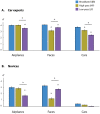Are all types of expertise created equal? Car experts use different spatial frequency scales for subordinate categorization of cars and faces
- PMID: 23826188
- PMCID: PMC3691146
- DOI: 10.1371/journal.pone.0067024
Are all types of expertise created equal? Car experts use different spatial frequency scales for subordinate categorization of cars and faces
Abstract
A much-debated question in object recognition is whether expertise for faces and expertise for non-face objects utilize common perceptual information. We investigated this issue by assessing the diagnostic information required for different types of expertise. Specifically, we asked whether face categorization and expert car categorization at the subordinate level relies on the same spatial frequency (SF) scales. Fifteen car experts and fifteen novices performed a category verification task with spatially filtered images of faces, cars, and airplanes. Images were categorized based on their basic (e.g. "car") and subordinate level (e.g. "Japanese car") identity. The effect of expertise was not evident when objects were categorized at the basic level. However, when the car experts categorized faces and cars at the subordinate level, the two types of expertise required different kinds of SF information. Subordinate categorization of faces relied on low SFs more than on high SFs, whereas subordinate expert car categorization relied on high SFs more than on low SFs. These findings suggest that expertise in the recognition of objects and faces do not utilize the same type of information. Rather, different types of expertise require different types of diagnostic visual information.
Conflict of interest statement
Figures



Similar articles
-
Expertise increases the functional overlap between face and object perception.Cognition. 2010 Dec;117(3):355-60. doi: 10.1016/j.cognition.2010.09.002. Epub 2010 Oct 8. Cognition. 2010. PMID: 20933227 Free PMC article.
-
Car expertise does not compete with face expertise during ensemble coding.Atten Percept Psychophys. 2021 Apr;83(3):1275-1281. doi: 10.3758/s13414-020-02188-8. Epub 2020 Nov 8. Atten Percept Psychophys. 2021. PMID: 33164130
-
Basic-level categorization of intermediate complexity fragments reveals top-down effects of expertise in visual perception.J Vis. 2011 Jul 28;11(8):18. doi: 10.1167/11.8.18. J Vis. 2011. PMID: 21799022 Free PMC article.
-
Subordinate-level object classification reexamined.Psychol Res. 1999;62(2-3):131-53. doi: 10.1007/s004260050047. Psychol Res. 1999. PMID: 10472199 Review.
-
What is special about expertise? Visual expertise reveals the interactive nature of real-world object recognition.Neuropsychologia. 2016 Mar;83:88-99. doi: 10.1016/j.neuropsychologia.2015.06.004. Epub 2015 Jun 18. Neuropsychologia. 2016. PMID: 26095002 Review.
Cited by
-
Beyond perceptual expertise: revisiting the neural substrates of expert object recognition.Front Hum Neurosci. 2013 Dec 27;7:885. doi: 10.3389/fnhum.2013.00885. Front Hum Neurosci. 2013. PMID: 24409134 Free PMC article. Review.
-
A perceptual field test in object experts using gaze-contingent eye tracking.Sci Rep. 2023 Jul 15;13(1):11437. doi: 10.1038/s41598-023-37695-9. Sci Rep. 2023. PMID: 37454134 Free PMC article.
References
Publication types
MeSH terms
Grants and funding
LinkOut - more resources
Full Text Sources
Other Literature Sources

